Understanding SWM Cess and Its Purpose (GS Paper 3, Economy)

Introduction
- The Solid Waste Management (SWM) Cess, proposed by the Bruhat Bengaluru Mahangara Palike (BBMP) at ₹100 per month per household, serves as a critical financial mechanism for Urban Local Bodies (ULBs) to manage and maintain effective solid waste management services.
- Here’s a detailed look into what SWM Cess entails and why it is levied on waste generators.
What is SWM Cess?
- SWM Cess, also known as user fees, is a charge imposed by ULBs on households and establishments for the collection, transportation, processing, and disposal of solid waste.
- It is a direct cost recovery mechanism mandated under the Solid Waste Management Rules, 2016, to fund the expenses incurred in providing SWM services.
Purpose of SWM Cess
- Funding SWM Services: The primary objective of SWM Cess is to finance the extensive and resource-intensive activities involved in managing solid waste. These include daily collection, transportation using a fleet of vehicles, processing organic and inorganic waste, and disposing of non-recyclable materials.
- Resource Intensity: Managing solid waste is highly labor-intensive and requires significant financial resources. ULBs allocate a substantial portion of their budgets—up to 50% in smaller cities and a significant amount in larger cities like Bangalore—to SWM services, highlighting the financial burden.
- Cost Distribution: SWM Cess helps distribute the costs of waste management services among the beneficiaries—residents and establishments that generate waste. It ensures that those directly contributing to waste generation bear a portion of the expenses associated with its management.
Challenges and Financial Realities
- Operational Costs: A large portion of SWM budgets, about 85-90%, is attributed to collection and transportation activities due to the sheer volume and dispersed nature of waste generation.
- Revenue Deficit: Despite the substantial expenditure, revenue generation from SWM services is minimal. This is largely because waste processing, particularly composting and biogas generation, often operates at a financial loss due to low yields and high operational costs.
- Financial Sustainability: ULBs face ongoing challenges in sustaining SWM services financially. The revenue generated from operational facilities covers only a fraction of the total expenses, necessitating subsidies from local governments.
Proposed Solutions and Mitigation Strategies
- Waste Segregation: Promoting source segregation of waste at households and establishments reduces the cost and complexity of waste processing, enhancing operational efficiency.
- Reducing Single-Use Plastics: Initiatives to minimize single-use plastics decrease the volume of non-biodegradable waste, thereby lowering transportation and disposal costs.
- Decentralized Initiatives: Encouraging decentralized composting and biogas production facilities at the community level reduces the burden on centralized processing facilities and enhances sustainability.
Conclusion
- The imposition of SWM Cess is crucial for sustaining and improving urban cleanliness and hygiene standards.
- It facilitates the equitable distribution of costs associated with solid waste management while promoting responsible waste practices among citizens and businesses.
- Moving forward, a combination of efficient waste management strategies and public awareness campaigns will be essential in optimizing SWM services and reducing the financial burden on ULBs.


